Metaphors for Change from Timpanogos High School
CompetencyWorks Blog
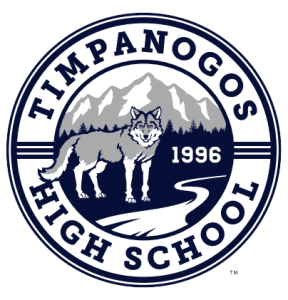 Timpanogos High School, one of ten high schools in Utah’s Alpine School District, began its shift to deep learning around seven years ago. The timeline in the Utah Spotlight on Timpanogos High School caught my eye, and the leadership team talked me through their journey and their taglines. These metaphors have helped create a school culture that supports their philosophy. “Sticky” touch points help us to shift our mental models in the change process. This post tells the story of change at Timpanogos through the metaphors that have helped them along the way.
Timpanogos High School, one of ten high schools in Utah’s Alpine School District, began its shift to deep learning around seven years ago. The timeline in the Utah Spotlight on Timpanogos High School caught my eye, and the leadership team talked me through their journey and their taglines. These metaphors have helped create a school culture that supports their philosophy. “Sticky” touch points help us to shift our mental models in the change process. This post tells the story of change at Timpanogos through the metaphors that have helped them along the way.
Getting Started with Deep Learning
Principal Dr. Joe Jensen began our conversation by sharing the origins of their work about a year into his tenure as principal in 2017. “We unapologetically and relentlessly said [deep learning] is what we care about, and I think we did it in a way where we involved the whole faculty. So it wasn’t a mandate. I don’t think this can be done well as a mandate.” Health teacher and professional learning coach Byron Tanner added that, “We don’t talk about it as a deeper learning program. It’s all about who we are.”
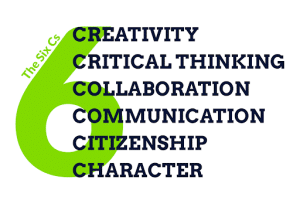 The decision to pursue deep learning was Timpanogos’ answer to how they would implement the Alpine School District Vision for Learning that was introduced around the same time. They credit Michael Fullan for the language of deep learning and the six Cs – creativity, critical thinking, collaboration, communication, citizenship, and character. Additionally, this language is closely echoed in nearly every deep learning initiative, from ISTE, P21, or Google to individuals like Ted Dintersmith or Tony Wagner. Jensen emphasizes that for Timpanogos, “it’s not knowledge, skills, and dispositions…Skills and dispositions are our goal. Knowledge is just the vehicle.”
The decision to pursue deep learning was Timpanogos’ answer to how they would implement the Alpine School District Vision for Learning that was introduced around the same time. They credit Michael Fullan for the language of deep learning and the six Cs – creativity, critical thinking, collaboration, communication, citizenship, and character. Additionally, this language is closely echoed in nearly every deep learning initiative, from ISTE, P21, or Google to individuals like Ted Dintersmith or Tony Wagner. Jensen emphasizes that for Timpanogos, “it’s not knowledge, skills, and dispositions…Skills and dispositions are our goal. Knowledge is just the vehicle.”
Deep learning is the school’s way to achieve their collective mission to “empower all students to become lifelong learners and contribute to society.” They have organized their work around two goals that have remained steady since their start:
- Deliberately foster connection and the well-being of students and staff
- Deliberately develop the 6Cs in students and staff.
Their goal clarity and consistency over time have been important contributing factors in their success.
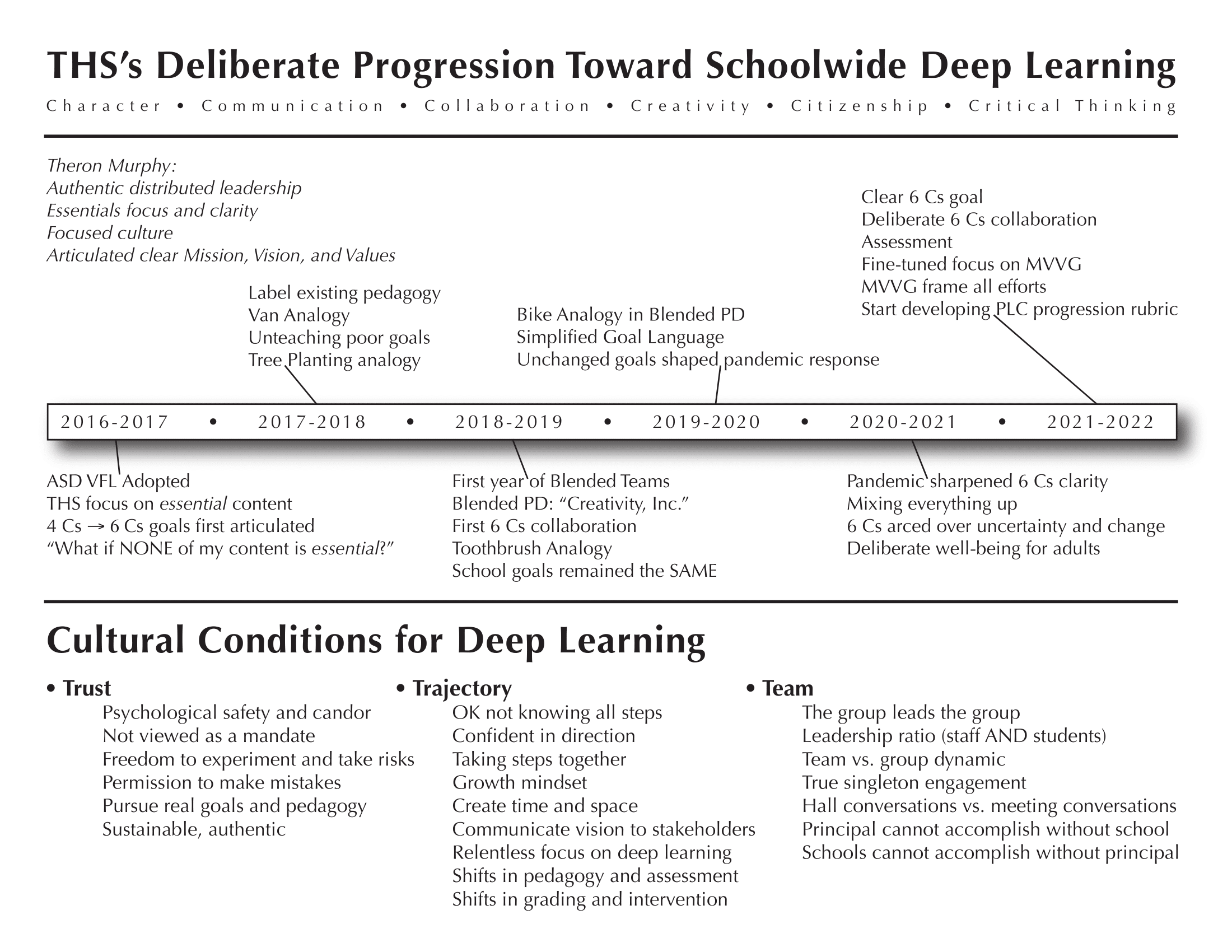 The Three Ts: The Cultural Conditions for Change
The Three Ts: The Cultural Conditions for Change
The leadership team underscored that their foundations for change and continuous improvement were stable leadership – Jensen has been principal since the start of this chapter, and the prior principal, Theron Murphy was there for eight years – and established structures for professional learning and collaboration that were crucial assets they built upon. As they reflect on their journey and look forward, they use the three Ts of Trust, Trajectory, and Team to guide them as essential ingredients in the change process.
Trust that the leadership supports changes and has teachers’ backs is the first layer of the foundation. Tanner notes, “There’s a trust that, ‘Hey, we’re going to do what’s best for students, we trust you as professionals, and it’s okay to try some things out, take some risks.’” They intentionally communicate that staff members have license to try things out and that they don’t have to hide it. He shared the story of one teacher who reflected, “I feel like I jumped out of a plane and I hit the ground really hard a couple of times when my parachute didn’t open…But I didn’t have a principal saying ‘You did that. What are you doing? That was the dumbest idea.’ It was like, ‘Hey, thanks for taking a risk. Thanks for trying to do something new.’”
Trajectory keeps the ultimate vision front and center. Social studies teacher and professional learning coach Brooke Davies, wordsmith of the three Ts, wanted to capture that the goal is not to get to a location and stop. “Trajectory” communicates that you never get there. Instead, you are always asking, “Where do we go from where we are?”
Team centers on the idea that in their professional learning community (PLC) culture of distributed leadership, everyone has a role to play in keeping the focus on learning. They underscore that the administrators are on board with learning, not just managing. Tanner adds, “The administrators we have are active participants in the learning that’s happening in the school with the teachers…they make the time and space to ensure that that is an important part of their job, and that we really are a team. They’re not just delegating.”
Everyone was clear that the shift towards deep learning takes time. Jensen said, “Just know that change didn’t happen overnight. It’s been a long, long process…There are always bumps in the road. But it’s a more fun road than the traditional road, even though it’s messy.”
The Van Analogy: The Destination Needs to Be Compelling
The tension between traditional disciplinary content knowledge and incorporating essential skills and dispositions (such as the 6Cs) will ring familiar to many high school educators. The team talked about a moment when a teacher asked, “What if none of my content is essential?” The idea of content as the vehicle for developing and applying higher order, transferable skills resonated with the leadership team. Principal Joe helped extend the metaphor with his family’s “beat-up passenger van” that they happened to be driving from Utah to North Dakota one summer when these discussions were happening at Timpanogos. “My kids will get in the van if we’re going somewhere good,” he said. So for teachers, “You may see your content as a fancy sports car, but many kids see your content as a broken down van.” Jensen noted, “shared metaphors create a powerful common foundation that promotes unity around our mission, vision, values, and goals.”
 The Tree Planting Analogy: Without a Deep Learning Goal, We’re Digging Holes and Filling Them Back In. Let’s Plant Trees!
The Tree Planting Analogy: Without a Deep Learning Goal, We’re Digging Holes and Filling Them Back In. Let’s Plant Trees!
In working to ensure that their PLC teams effectively moved practice, they designed a tree planting experience to affirm the three big ideas of PLCs – a focus on learning, a culture of collaboration, and a results orientation. On the final contracted day in May, they told teachers to come ready to plant trees. Everyone dug a hole to plant a tree, but only one half of the teachers got a tree to plant; the other half were told to just fill their hole back in. The message was clear: if you don’t have deep learning goals for your PLC or for your classes, then “you’re just digging holes and filling them back in.” Nothing grows for the long term if you haven’t actually planted and nurtured a deep learning goal.
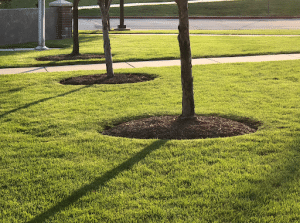 Toothbrush Analogy: Learning is Ongoing, Not Just On PD Days
Toothbrush Analogy: Learning is Ongoing, Not Just On PD Days
Building a culture of continuous improvement means that learning and reflection happen as a natural part of the day-to-day rhythm of work. As they started to introduce personalized, blended professional development (PD) options, the message included the idea that we don’t just brush our teeth one time before going to the dentist. Oral hygiene – and deep learning – takes consistency. Assistant principal Ryan Francom explains, “You can’t brush your teeth for five hours in one day and have it equal five weeks of five minutes a day.” The image helped to communicate that learning wasn’t just eight hours of “butts in seats in the media center on a PD day.
Riding a Bike: Focus on the Key Element and the Rest Follows
As they started shifting the PLC results cycle to focus on deep learning, many people had questions about where to start and what to do about different elements of practice. Jensen was teaching his son how to ride a bike at the time and shared the idea that the key skill is balance and that if you can teach balance, everything else falls into place. On the other hand, if you try to focus on everything at once, “it’s a miserable experience – the kid is crying, the parents are crying, there are bandaids.” The metaphor helped assure staff that if they focus on a deep learning goal, other shifts in instruction, assessment, and the learning culture are going to come. And it also helped several staff members teach their kids to ride a bike that summer as evidenced by the videos sent to Jensen!
Bike Analogy Bonus: Making the Case for CBE
As we closed our conversation, I reciprocated with my own favorite bike analogy. The big idea of competency-based education – which I see as in the same space as deep learning – focuses on designing the system around what we want kids to learn and how we know when they do learn. If we want kids to learn how to ride a bike, and I take a little longer to learn how to ride a bike than Joe, the traditional time-focused system rewards Joe – “Oh, he’s a fast learner!” – and he’s going to accelerate. But how long is the system going to hold it against me? Once I learn how to ride a bike, I can ride a bike. I might even get better quickly once I get it, or decide that I’m really into mountain biking and I might specialize. On the other hand, if I can only 70% ride a bike, but the curriculum pacing guide says it’s time to move on, that’s also not great. Where do I get the support to be able to take off my training wheels? Once I can ride my bike, Joe and I can go bike riding together. The focus on the learning outcome – the 6Cs in Timpanogos – is central in a CBE system.
Charting Your Community’s Journey
Timpanogos’ journey developed over the same time period as the evolution of Utah’s Personalized, Competency-Based Learning (PCBL) Framework. Though they only started to engage with the language of PCBL in the last couple of years, they see the parallels and connections to their deep learning work. Connecting to the work going on in Utah beyond their district helped validate their work and find ideas for going forward. Change is an ongoing process, and the metaphors that have emerged over time in Timpanogos keep the memory of the process alive as they continue on.
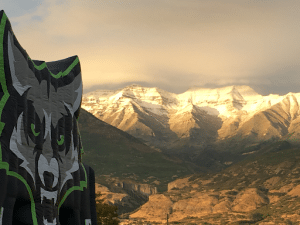 Learn More
Learn More
- Utah’s Launchpad to Personalized, Competency-Based Learning
- 4 Keys to Building Deeper Critical and Creative Thinking in Your Classroom
- Implementation with Integrity
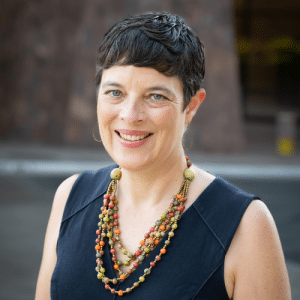 Laurie Gagnon is the CompetencyWorks Program Director at the Aurora Institute. She leads the work of sharing promising practices shaping the future of K-12 personalized, competency-based education (CBE). While in Utah for the first Magellan Summit on Personalized, Competency-Based Learning (PCBL) in January 2023, she had the opportunity to talk to school leaders from Timpanogos High School while admiring the snowy mountains.
Laurie Gagnon is the CompetencyWorks Program Director at the Aurora Institute. She leads the work of sharing promising practices shaping the future of K-12 personalized, competency-based education (CBE). While in Utah for the first Magellan Summit on Personalized, Competency-Based Learning (PCBL) in January 2023, she had the opportunity to talk to school leaders from Timpanogos High School while admiring the snowy mountains.